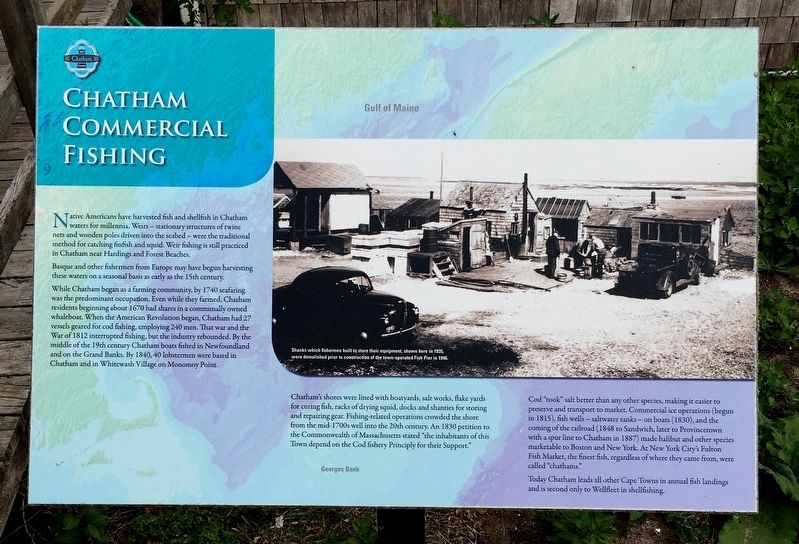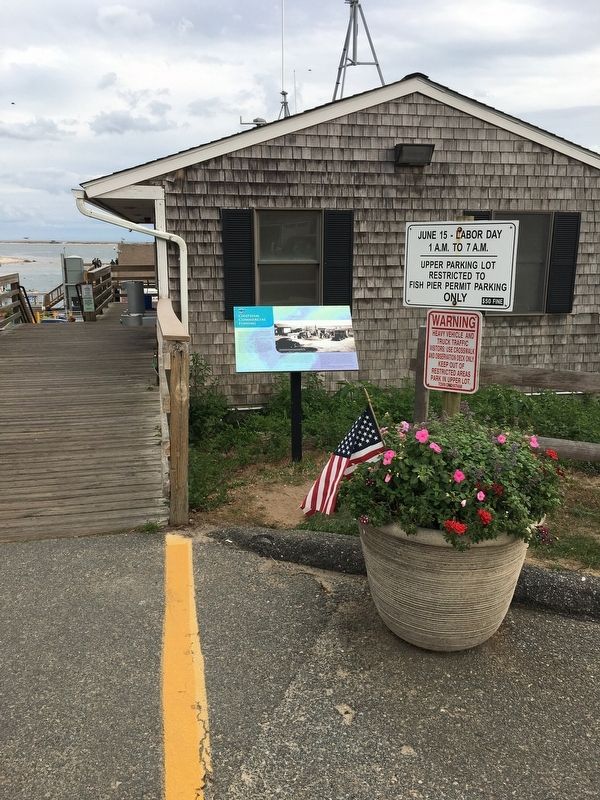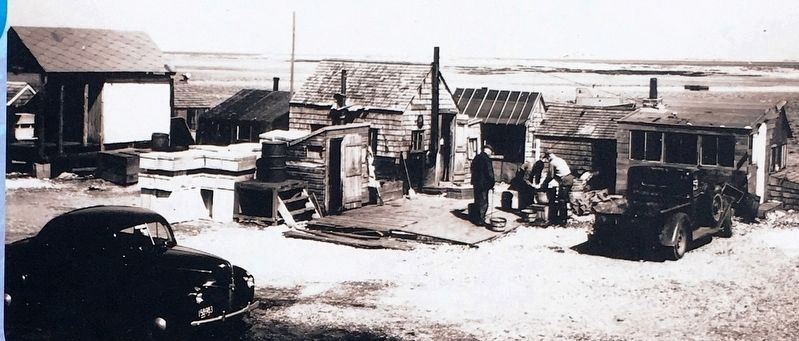Chatham in Barnstable County, Massachusetts — The American Northeast (New England)
Chatham Commercial Fishing
Native Americans have harvested fish and shellfish in Chatham waters for millennia. Weirs – stationary structures of twine nets and wooden poles driven into the seabed – were the traditional method for catching finfish and squid. Weir fishing is still practiced in Chatham near Hardings and Forest Beaches.
Basque and other fisherman from Europe may have begun harvesting these waters on a seasonal basis as early as the 15th century.
While Chatham began as a farming community, by 1740 seafaring was the predominant occupation. Even while they farmed, Chatham residents beginning about 1670 had shares in a communally owned whaleboat. When the American Revolution began, Chatham had 27 vessels geared for cod fishing, employing 240 men. That war and the War of 1812 interrupted fishing, but the industry rebounded. By the middle of the 19th century Chatham boats fished in Newfoundland and the Grand Banks. By 1840, 40 lobstermen were based in Chatham and in Whitewash Village on Monomoy Point.
Chatham shores were lined with boatyards, salt works, flake yards for curing fish, racks of drying squid, docks and shanties for storing and repairing gear. Fishing-related operations crowded the shore from the mid-1700s well into the 20th century. An 1830 petition to the Commonwealth of Massachusetts stated “the inhabitants of this Town depend on the Cod fishery Principly for their Support.”
Cod “took” salt better than any other species, making it easier to preserve and transport to market. Commercial ice operations (begun in 1815), fish wells – saltwater tanks – on boats (1830), and the coming of the railroad (1848 to sandwich, later to Provincetown with a spur line to Chatham in 1887) made halibut and other species marketable to Boston and New York. At New York City’s Fulton Fish Market, the finest fish, regardless of where they came from, were called “chathams.”
Today Chatham leads all other Cape Towns in annual fish landings and is second to Wellfleet in shellfishing.
Topics. This historical marker is listed in these topic lists: Industry & Commerce • Waterways & Vessels.
Location. 41° 41.286′ N, 69° 57.111′ W. Marker is in Chatham, Massachusetts, in Barnstable County. Marker is at the intersection of Barcliff Avenue and Shore Road (Massachusetts Route 28), on the right when traveling west on Barcliff Avenue. The marker is located in front of the Chatham Fish Pier. Touch for map. Marker is at or near this postal address: 45 Barcliff Avenue, Chatham MA 02633, United States of America. Touch for directions.
Other nearby markers. At least 8 other markers are within walking distance of this marker. Chatham's Fishing Fleet (here, next to this marker); Captain David F. Ryder (within shouting distance of this marker); Chatham Railroad Depot (approx. half a mile away); Chatham Civil War Monument (approx. 0.6 miles away); In Memory of the Pioneers of Chatham (approx. 0.6 miles away); The Josiah Mayo House (approx. 0.6 miles away); History of Chatham (approx. 0.6 miles away); a different marker also named History of Chatham (approx. 0.6 miles away). Touch for a list and map of all markers in Chatham.
Credits. This page was last revised on November 18, 2023. It was originally submitted on November 1, 2020, by Brandon D Cross of Flagler Beach, Florida. This page has been viewed 218 times since then and 40 times this year. Last updated on October 15, 2023, by Darren Jefferson Clay of Duluth, Georgia. Photos: 1, 2, 3. submitted on November 1, 2020, by Brandon D Cross of Flagler Beach, Florida. • Michael Herrick was the editor who published this page.


